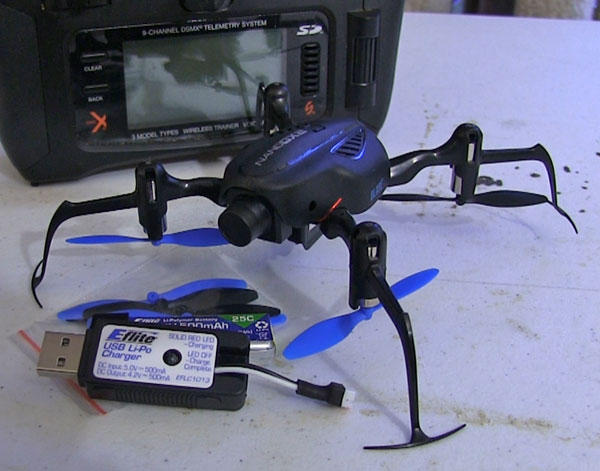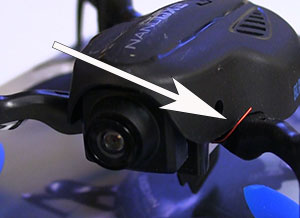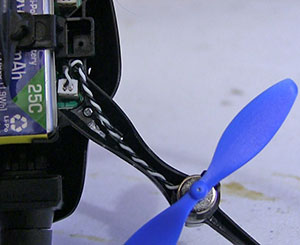



Text, photos and video by Tom Hintz
Posted – 12-14-2016
Faced with a prolonged period away from the flying field to battle cancer I needed a way to keep my radio fingers familiar with the task of flying RC, for the time being in the house. Some form of small helicopter is the only thing that made any sense. Recently when I had a friend mention flying a small quad while watching on his big screen TV rather than FPV (first person view) goggles I thought I had come across the perfect way to maintain some level of educated RC fingers without endangering everything and everyone in my house.
Though I had not been a big Blade fan I had been hearing good things about their tiny quads so began investigating their lineup. The Blade Nano QX2 FPV BNF (BLH9180) seemed to be what I was looking for so I got one and the education of my RC fingers (and brain) continues.
The Blade Nano QX2 comes fully assembled including the FPV camera system. In this case I love the idea of BNF (bind and fly) because I am looking for simple flight in a confined space so I just needed an aircraft that functions normally. The Blade Nano QX2 did just that once I bound it to my Spektrum DX9. It wasn’t overly easy to fly but I am sure the major difficulties came from my lack of quad skills and not in a deficiency of the Blade Nano QX2 itself. I needed practice but I was counting on that so the plan was working.
The Blade Nano QX2 is 1.96 in (50mm) tall, 5.11 in (130mm) long/wide and weighs in at a remarkable 1.83 oz (52g)! That low weight is largely responsible for the 6 to 8-minute expected flight times from the 1S 500mAh 25C LiPo battery (UMX Connector) battery. The kit includes one of these batteries as well as a USB charger for it.
The Blade Nano QX2 is built around a very flexible plastic frame that actually helps protect it from damage during the inevitable crashes. There is so little weight that letting the “legs” flex absorbs the impact before it can damage the quad. Note the fin on the belly of the Blade Nano QX2 that limits the downward movement of the main portion of the airframe so the blades can’t touch down during landings that distort the legs.
The brushless motors are pressed into cups in each leg and have a plug-in connector that makes changing motors out quick and easy. Eliminating this solder joint is a good thing for most users. Also, the props press onto the motor shafts so you can change them easily with no tools. Blade sends an extra set of props along in the kit.

The Blade Nano QX2 comes with a 25mW micro FPV camera system (with lens cap) installed at the factory. The camera sends video to common 5.8GHz headsets or as in my case, a 5.8GHz AV receiver that I plug into my big screen TV to see where my Blade Nano QX2 is going, or about to hit.
The video transmitter has 7 channels in the F band common to many FatShark, Immersion and Airwave receivers. A simple button on the top of the Blade Nano QX2 body cycles through the transmitter channels.
The camera lens can be adjusted up and down through several degrees to best accommodate your flying speed or style. Once you establish the camera angle that is best for you it can be locked in place so a simple crash does not alter your view of the world.
The Blade Nano QX2 features their SAFE™ (Sensor Assisted Flight Envelope) technology that takes some of the frustration out of learning to fly a quad. This system has two modes, one for beginners and a second for when you think you have a handle on flying the Blade Nano QX2.
The “Beginner” mode self-levels when you let go of the sticks. It also limits banking to 20-degrees so you don’t flip the Blade Nano QX2 over by accident. Yes, it can happen……don’t ask how I know. Though beginner’s mode sounds restrictive you can actually fly quite fast with good maneuverability.
“Agility” mode is aptly named because the Blade Nano QX2 is fully aerobatic and for the newer pilot, nearly impossible to handle, at first. Spend some time in Beginner mode and work your way into the Agility flight and you will surprise yourself with that you can do. Practice is necessary, as is some crashing but the learning process is part of the fun.

I should admit that my plan of flying the Blade Nano QX2 in the house using my big screen TV as my “goggles” turned out to be a tad more difficult than I anticipated. But using the Beginners mode and logging practice time to gain a little familiarity with the Blade Nano QX2 I was cruising the house with fewer and fewer crashes. In the process, I was confirming the toughness of the Blade Nano QX2. A couple of the blade tips were showing wear/damage but it was minor and not impacting flight noticeably.
It is becoming clear that the easiest way to compromise the flight stability of the Blade Nano QX2 is to let it initialize on a surface that is not level. The gyros recognize whatever surface you set it on as “flat” to the world so when you lift off the ground it naturally tries to assume the same out of level condition as the surface it initialized on. The gyros appear to be sensitive enough that considering a surface to be “level enough” can begin a not-so-fun flight.
The Blade Nano QX2 has no outside LED’s to make recognizing the front and back of the nearly all black quad easier to determine even when it is just 20 or so feet away. In such confined areas moments of indecision about which way to move the sticks usually end in a crash. Of course, this is an issue only when flying “line of sight”.
While test flying the Blade Nano QX2 I came across a small problem that I should have expected. Early on I noticed the tiny copper wire “antenna” that poked out from under the body shell near one of the frame legs. Even my brief experience with racing quads was more than sufficient to point out the need for quality antennas if distance and video signal quality is important. I expect that the 25mw video output and that little antenna would be fine with clear line of sight. However, when flying beyond walls, a bank of metal folding doors and a staircase, the video can become degraded and unstable to some extent. The manual includes a warning about the range of the video transmitter being less than that of the radio controlling the Blade Nano QX2.
I tried several of the channels in the Blade Nano QX2 and found one that was more stable than the others. Perhaps something in my house was conflicting with the other channels, I just don’t know. Considering the amount of wood, metal, wiring and plumbing that could be in the walls I was flying on the other side of, the video quality might be better than I should expect. The good news is that it works and I can fly farther in my house than I am currently able to fly back from without crashing most of the time. The room for progress in my quad piloting skills is what I was looking for to keep my fingers familiar with RC controls.
The Blade Nano QX2 is a good quad for indoor flying and perhaps some outdoor adventures when there is very little to no wind. The frame and body are tougher than I anticipated as are the props. Because the props are a friction fit on the motor shafts they will eventually wear out, particularly if you don’t chop the power when the Blade Nano QX2 crashes. The angle of the legs insures more crashes than are necessary but apparently they do protect the props well. I have to say that the frame does seem tough as I have exactly “who-knows-how-many” crashes on my Blade Nano QX2 and the frame looks like it did when it came from the box.
The video range problem is an issue only when the amount of walls and other in-home obstructions add up. Everything I have seen during this evaluation is that line of sight range for the Blade Nano QX2 video is more than sufficient. Flying room-to-room within a house puts higher demands on the video system but so far it works well enough that flying remains entertaining and challenging when I try to fly through or around stuff I probably shouldn’t.
Another real video shortcoming for some with be the lack of on board video recording. The Blade Nano QX2 is set up so that the only option for recording video is on the receiver end which guarantees degraded video because of the processing needed for transmission. The remarkable low weight of the Blade Nano QX2 makes adding on board video recording tough but not impossible. The Blade Glimpse FPV BNF is essentially the same airframe as the Blade Nano QX2 glimpse FPV BNF but the Glimpse comes with video recording.
With a street price of just $159.99 (12-14-2016) the Blade Nano QX2 is an economical way to enter the quad FPV world. It is not a racer but is capable of what will appear to be blinding speeds when you first try flying in FPV mode. The Blade Nano QX2 has all of the handling you need to fly scary tight courses or for just jamming around a couple rooms in the house. When you need more performance you simply kick it into Agility mode and the Blade Nano QX2 becomes 3D capable and a hyper agile animal when your skills let you attack a course or the random openings found in a home.
If you are looking to get into FPV flying, especially in an indoor facility or outside on calm days, the Blade Nano QX2 needs to be on your “must see” list. I found out immediately that the Blade Nano QX2 had skills way beyond mine which means I have many hours of fun practice as I work on my stick skills to get a better handle on the Blade Nano QX2 at speed.
Visit the Blade Nano QX2 product page – Click Here
Have a comment on this review? –Email Me